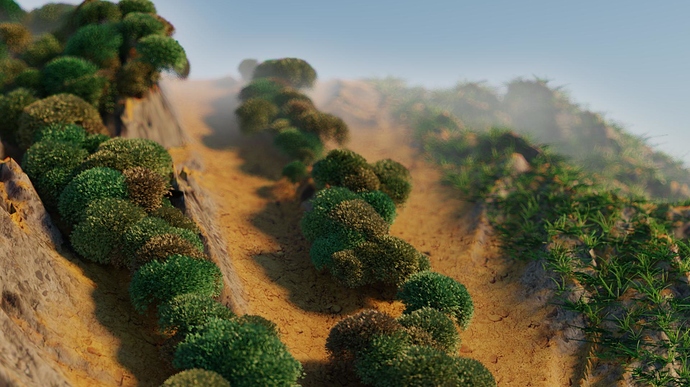First, code used for the grass.
import numpy as npimport bpy,mathutils
from random import random,randrange,getrandbits
def space():
return randrange(-10000,10000)/100
def randhalf():
return random()*2-1
ints=bpy.data.objects['hf_x00y00.001']
tree=mathutils.bvhtree.BVHTree.FromObject(ints,bpy.context.scene,render=True, epsilon=0.0001)
for tog in range(3):
curve = bpy.data.curves.new('ProceduralGrass', 'CURVE')
curve.dimensions = '3D'
curve.bevel_depth=.1
curve.bevel_resolution=1
curve.resolution_u=2
curve.twist_mode='TANGENT'
curve.twist_smooth=.13
count=0
for y in np.arange(0,165,.1):
for x in np.arange(120,240,.1):
if not getrandbits(10):
x+=random()
y+=random()
rc=tree.ray_cast((x,y,200),(0,0,-1),200.0)
if rc[0]!=None:
#vert.co=rc[0]
#vert.normal=rc[1]
count+=1
place=(*rc[0],1)
scale=random()*.1+.1
for j in range(randrange(3,13)):
x,y,z,w=place
spline = curve.splines.new(type='NURBS')
spline.points.add(3)
spline.points[1].co=(x,y,z,w)
spline.points[1].radius=10*scale
spline.points[0].co=(x+randhalf()*2*scale,y+randhalf()*2*scale,z-4*scale,10*scale)
spline.points[0].radius=30*scale
x+=randhalf()*((4+tog)**2)*scale
y+=randhalf()*((4+tog)**2)*scale
z+=random()*((5-tog)**2)*scale
spline.points[2].co=(x,y,z,w)
spline.points[2].radius=3*scale
x+=randhalf()*((8+tog)**2)*scale
y+=randhalf()*((8+tog)**2)*scale
z+=random()*((4-tog)**2)*scale
spline.points[3].co=(x,y,z,w)
spline.points[3].radius=2*scale
curve_object = bpy.data.objects.new('ProceduralGrass', curve)
scene = bpy.context.scene
scene.objects.link(curve_object)
curve_object.location=ints.location
print(count)
Second, the render itself. I was trying to keep it simple.

